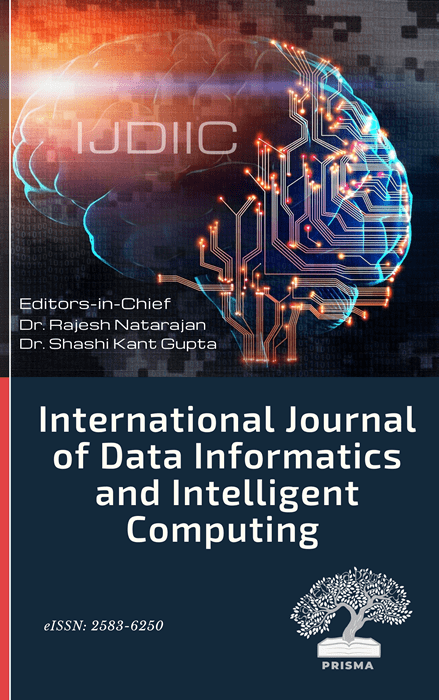Automated Fall Detection for Disabled Individuals Using Mobile Phone Sensors and Machine Learning: A Survey
DOI:
https://doi.org/10.59461/ijdiic.v3i2.106Keywords:
Fall detection , Machine Learning, Mobile Sensors, Elderly CareAbstract
Fall risks to health and safety are especially dangerous for those with impairments. An automated fall detection system is necessary, especially in medical and senior care. The elderly and individuals with impairments are particularly susceptible to falls, which frequently result in severe injuries and complications, thereby presenting a considerable threat to their overall health. The early discovery and response to a fall incidence can reduce immobilization and consequent health complications, saving lives. Automatic fall detection systems quickly and reliably indicate falls and dispatch medical or emergency assistance. Researchers have introduced various automatic fall detection methods using machines or deep learning. Most fall detection systems depend on wearable or stationary sensors, which restricts the user's mobility and accessibility. Conversely, mobile sensor-based fall detection leverages the widespread presence of smartphones by obtaining motion information via their integrated accelerometers and gyroscopes. Our primary objective is to develop a reliable fall detection method using a mobile phone sensor and machine learning. This paper examines several methods employed in the identification of falls and emphasizes the significance of utilizing mobile phone sensors in the process of fall detection. It also discusses recent research in this domain and highlights research challenges. This could potentially foster further innovation in the field.
Downloads
References
A. Axmon, G. Ahlström, and M. Sandberg, “Falls resulting in health care among older people with intellectual disability in comparison with the general population,” J. Intellect. Disabil. Res., vol. 63, no. 3, pp. 193–204, Mar. 2019, doi: 10.1111/jir.12564.
Y. Li, L. Hou, H. Zhao, R. Xie, Y. Yi, and X. Ding, “Risk factors for falls among community-dwelling older adults: A systematic review and meta-analysis,” Front. Med., vol. 9, Jan. 2023, doi: 10.3389/fmed.2022.1019094.
[Online]. Available: https://www.omanobserver.om/article/1102483/oman/community/over-42k-omani-person-with-disabilities
S. Usmani, A. Saboor, M. Haris, M. A. Khan, and H. Park, “Latest Research Trends in Fall Detection and Prevention Using Machine Learning: A Systematic Review,” Sensors, vol. 21, no. 15, p. 5134, Jul. 2021, doi: 10.3390/s21155134.
L. Hazelhoff, J. Han, and P. H. N. de With, “Video-Based Fall Detection in the Home Using Principal Component Analysis,” 2008, pp. 298–309. doi: 10.1007/978-3-540-88458-3_27.
N. Mamchur, N. Shakhovska, and M. Gregus ml., “Person Fall Detection System Based on Video Stream Analysis,” Procedia Comput. Sci., vol. 198, pp. 676–681, 2022, doi: 10.1016/j.procs.2021.12.305.
M. Cheffena, “Fall Detection Using Smartphone Audio Features,” IEEE J. Biomed. Heal. Informatics, vol. 20, no. 4, pp. 1073–1080, Jul. 2016, doi: 10.1109/JBHI.2015.2425932.
M. Salman Khan, M. Yu, P. Feng, L. Wang, and J. Chambers, “An unsupervised acoustic fall detection system using source separation for sound interference suppression,” Signal Processing, vol. 110, pp. 199–210, May 2015, doi: 10.1016/j.sigpro.2014.08.021.
P. Kulurkar, C. kumar Dixit, V. C. Bharathi, A. Monikavishnuvarthini, A. Dhakne, and P. Preethi, “AI based elderly fall prediction system using wearable sensors: A smart home-care technology with IOT,” Meas. Sensors, vol. 25, p. 100614, Feb. 2023, doi: 10.1016/j.measen.2022.100614.
J. Liu et al., “A review of wearable sensors based fall-related recognition systems,” Eng. Appl. Artif. Intell., vol. 121, p. 105993, May 2023, doi: 10.1016/j.engappai.2023.105993.
Q. Zhang and M. Karunanithi, “Feasibility of unobstrusive ambient sensors for fall detections in home environment,” in 2016 38th Annual International Conference of the IEEE Engineering in Medicine and Biology Society (EMBC), IEEE, Aug. 2016, pp. 566–569. doi: 10.1109/EMBC.2016.7590765.
M. E. Karar, H. I. Shehata, and O. Reyad, “A Survey of IoT-Based Fall Detection for Aiding Elderly Care: Sensors, Methods, Challenges and Future Trends,” Appl. Sci., vol. 12, no. 7, p. 3276, Mar. 2022, doi: 10.3390/app12073276.
A. Hakim, M. S. Huq, S. Shanta, and B. S. K. K. Ibrahim, “Smartphone Based Data Mining for Fall Detection: Analysis and Design,” Procedia Comput. Sci., vol. 105, pp. 46–51, 2017, doi: 10.1016/j.procs.2017.01.188.
M. Habib, M. Mohktar, S. Kamaruzzaman, K. Lim, T. Pin, and F. Ibrahim, “Smartphone-Based Solutions for Fall Detection and Prevention: Challenges and Open Issues,” Sensors, vol. 14, no. 4, pp. 7181–7208, Apr. 2014, doi: 10.3390/s140407181.
A. Boehner, “A Smartphone Application for a Portable Fall Detection System,” Proc. Natl. Conf. Undergrad. Res., 2013.
A. A. Kadhum, H. Al-Libawy, and E. A. Hussein, “An Accurate Fall Detection System for the Elderly People Using Smartphone Inertial Sensors,” J. Phys. Conf. Ser., vol. 1530, no. 1, p. 012102, May 2020, doi: 10.1088/1742-6596/1530/1/012102.
P. Tsinganos and A. Skodras, “A smartphone-based fall detection system for the elderly,” in Proceedings of the 10th International Symposium on Image and Signal Processing and Analysis, IEEE, Sep. 2017, pp. 53–58. doi: 10.1109/ISPA.2017.8073568.
Y. Harari, N. Shawen, C. K. Mummidisetty, M. V. Albert, K. P. Kording, and A. Jayaraman, “A smartphone-based online system for fall detection with alert notifications and contextual information of real-life falls,” J. Neuroeng. Rehabil., vol. 18, no. 1, p. 124, Dec. 2021, doi: 10.1186/s12984-021-00918-z.
L. Nooyimsai, O. Pakdeepong, S. Chatchawalvoradech, T. Phiakhan, and S. Laitrakun, “Smartphone-Based Human Activity and Fall Recognition Using Deep Feature Extraction and Machine-Learning Classifiers,” in 2022 17th International Joint Symposium on Artificial Intelligence and Natural Language Processing (iSAI-NLP), IEEE, Nov. 2022, pp. 1–6. doi: 10.1109/iSAI-NLP56921.2022.9960250.
S.-H. Fang, Y.-C. Liang, and K.-M. Chiu, “Developing a mobile phone-based fall detection system on Android platform,” in 2012 Computing, Communications and Applications Conference, IEEE, Jan. 2012, pp. 143–146. doi: 10.1109/ComComAp.2012.6154019.
I. N. Figueiredo, C. Leal, L. Pinto, J. Bolito, and A. Lemos, “Exploring smartphone sensors for fall detection,” mUX J. Mob. User Exp., vol. 5, no. 1, p. 2, Dec. 2016, doi: 10.1186/s13678-016-0004-1.
[Online]. Available: https://www.analyticsvidhya.com/blog/2020/12/understand-machine-learning-and-its-end-to-end-process/
Downloads
Published
How to Cite
Issue
Section
License
Copyright (c) 2024 Asma Abdallah Nasser Al-Risi, Shamsa Salim Mattar Albadi, Shima Hamdan Said Almaamari, Saleem Raja Abdul Samad, Pradeepa Ganesan

This work is licensed under a Creative Commons Attribution-ShareAlike 4.0 International License.








